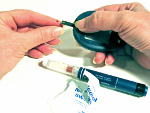A Diabetes Primer
Author: tiger Published Under: Health

Diabetes is a disease that is becoming increasingly common in countries like the United States, with many studies now indicating that it is closely tied to obesity and diet. At its most basic, diabetes is a disease that affects the way the body processes and uses sugar, which is an important source of energy. It is closely tied to insulin, which is the main hormone used by the body to process sugar.
Depending on the type of diabetes, the body may produce too much insulin or not enough. It is also common for the body to not properly use the insulin it has, becoming resistant to its effects. In return, this can cause the body to not be able to use sugar as a source of energy, instead breaking down fat or muscle.
Processing Sugar in a Healthy Body
Sugar, or glucose, is an essential source of energy used by the body. However, glucose is not only found in sweets, but is also found in foods high in carbohydrates, such as bread and rice. Glucose provides a quick and powerful source of energy, being passed into the blood stream after being digested.
Once in the blood stream, the glucose is used by different cells, with a hormone called insulin enabling the cells to absorb the glucose. Insulin is always present in the blood stream, but after eating insulin levels increase, allowing the glucose to be used for energy.
Glucose that isn't used right away is stored as glycogen, mostly in the liver, as well as in the muscles. If a person goes to long without eating, a hormone called glucagon is released, which helps turn the stored glycogen back into energy.
Both Glucagon and Insulin are produced in the pancrease.
How Diabetes Affects the Body
In someone with diabetes, the system used to break down and process glucose fails. This can happen in several ways, with the body sometimes not producing enough insulin or other times becoming resistant to the effects of insulin. As a result, glucose begins to buildup in the bloodstream.
When the glucose levels gets too high, this can cause a number of symptoms, such as frequent urination as the kidneys flush excess glucose out of the body. Also, since the body is not able to get any energy from glucose, it must turn to other sources to power the body, frequently breaking down fats and muscle tissue. In addition to causing weight loss and deterioration of muscles, the rapid breaking down of fats releases dangerous chemicals into the blood stream.
The way the body reacts and produces insulin is used to differentiate between the different types of diabetes.
In Type I Diabetes the pancreas does not produce any insulin, which is thought to be caused by an autoimmune response in the body, where the body attacks healthy beta-cells in the pancreas. Previously, Type I Diabetes had been called juvenile onset diabetes, as it was thought to only occur in children. However, it can develop in people of all ages.
In Type II Diabetes, which is the most common type of diabetes, the body becomes resistant to insulin, does not produce enough insulin, or experiences a combination of these symptoms. Type II Diabetes is thought to be closely linked to diet and obesity, with the disease becoming increasingly common in Western Societies. It was once called maturity onset diabetes, as it was usually only found in adults, but more and more children are now developing Type II Diabetes.
Gestational Diabetes shares similarities with Type II Diabetes and develops during pregnancy in some women, ultimately going away after the child is born. This is the only known temporary type of diabetes, but studies have found that those that develop gestational diabetes are at a greater risk for developing Type II Diabetes later in life.